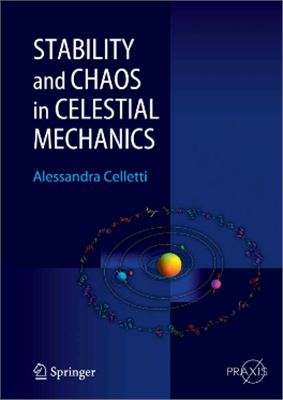Springer, 2009. - 264 pages.
Alessandra Celletti’s proposed book presents classical celestial mechanics and its interplay with dynamical systems in a way that would be suitable for advance level undergraduate students as well as postgraduate students and researchers. First she uses paradigmatic models, such as the logistic map or the standard map, to introduce the reader to the concepts of order, chaos, invariant curves, cantori, etc. The main numerical methods to investigate a dynamical system are presented: Poincare' maps, Lyapunov exponents, frequency analysis, Fast Lyapunov Indicators, etc. Then she reviews the classical two-body problem and proceeds to explore the three-body model in order to investigate orbital resonances and Lagrange solutions. As far as rotational dynamics are conceed, she details the derivation of the rigid body motion, and continues by discussing related topics, from spin-orbit resonances to dumbbell satellite dynamics.
Perturbation theory is then explored in full detail, both in classical, resonant and degenerate cases; practical examples of the application of perturbation theory are presented in connection to the precession of the perihelion or to the precession of the equinoxes. The main ideas of KAM theory are provided, and also a dissipative version of the theorem is discussed; furthermore long-term stability and converse KAM results are presented. She then explains the implementation of computer-assisted techniques, which allow the user to obtain rigorous results in good agreement with the astronomical expectations.
A perturbative approach to find periodic orbits is presented together with an application to the computation of the libration in longitude of the Moon. The study of collisions in the solar system is approached through regularization theory.
Alessandra Celletti’s proposed book presents classical celestial mechanics and its interplay with dynamical systems in a way that would be suitable for advance level undergraduate students as well as postgraduate students and researchers. First she uses paradigmatic models, such as the logistic map or the standard map, to introduce the reader to the concepts of order, chaos, invariant curves, cantori, etc. The main numerical methods to investigate a dynamical system are presented: Poincare' maps, Lyapunov exponents, frequency analysis, Fast Lyapunov Indicators, etc. Then she reviews the classical two-body problem and proceeds to explore the three-body model in order to investigate orbital resonances and Lagrange solutions. As far as rotational dynamics are conceed, she details the derivation of the rigid body motion, and continues by discussing related topics, from spin-orbit resonances to dumbbell satellite dynamics.
Perturbation theory is then explored in full detail, both in classical, resonant and degenerate cases; practical examples of the application of perturbation theory are presented in connection to the precession of the perihelion or to the precession of the equinoxes. The main ideas of KAM theory are provided, and also a dissipative version of the theorem is discussed; furthermore long-term stability and converse KAM results are presented. She then explains the implementation of computer-assisted techniques, which allow the user to obtain rigorous results in good agreement with the astronomical expectations.
A perturbative approach to find periodic orbits is presented together with an application to the computation of the libration in longitude of the Moon. The study of collisions in the solar system is approached through regularization theory.

